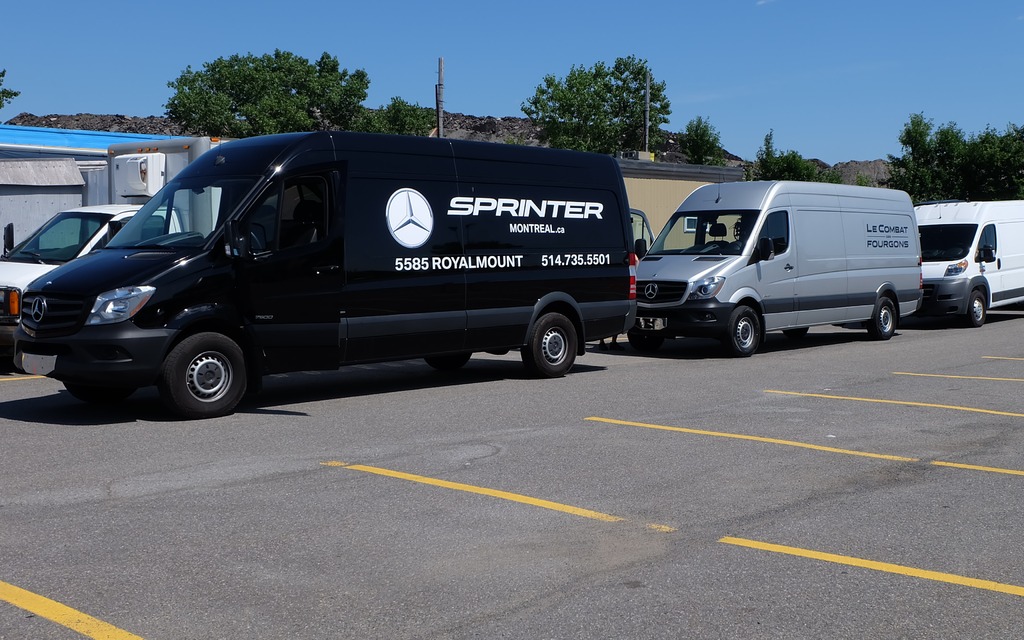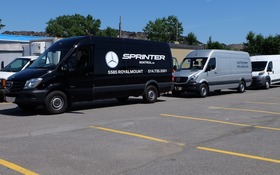2014 Mercedes-Benz Sprinter: Battle Of The Vans
On a beautiful, sunny day, Mercedes-Benz invited me to come and meet its line of Sprinter vans, updated for 2014. My experience with vans was pretty limited; I’d quickly driven a 1987 GMC Van a few years prior, but that was about it. I felt ill-prepared to compare the new Sprinter to the competition, as I didn’t really have a good grasp on the basic assessment criteria. Good news awaited me. The event was organized for potential buyers and Mercedes-Benz was so confident in its Sprinter that they also brought in a Ram ProMaster and Ford Transit to provide a basis of comparison. Let the Battle of the Vans begin!
A convoy of cabinets
After giving us a quick overview of the competitors, the event hosts directed us to a line of vehicles ready for testing. We climbed aboard and made ourselves comfortable (some more than others), adjusted the controls and off we went! The Sprinter immediately took the lead. This German van was quieter than the rest and offered better visibility. Equipped with large mirrors, the Sprinter is easy to maneuver onto the highway. Its robust dashboard is made of top-quality materials, and as automobile journalist, I had fun pointing out the various parts taken from the brand’s other vehicles: the old C Class’s steering wheel, the B Class’s dashboard, the S Class’s cruise control stalk from 2002, etc. All these parts have proven their worth and come together nicely in this van. There are ubiquitous storage compartments and even though my model had few accessories, this type of vehicle is very adjustable and can be adapted to almost any job.
A parking lot, orange cones and commercial vehicles
With the road test behind us, we headed to a massive parking lot where an obstacle course had been set up. We were asked to do a few avoidance maneuvers and some emergency braking. In a car, this would have been easy, but none of these vans (not even the Mercedes-Benz) was designed for the slalom! But once again, the Sprinter rose to the occasion. Thanks to its advanced stability control and anti-skid systems, even the most aggressive attempts to throw the massive box off its wheels proved ineffective. No matter how sharp the maneuver, the Sprinter remained perpendicular to the ground, with four wheels firmly planted on the pavement. In emergency situations, that’s exactly the kind of handling you want!
The Sprinter was the only vehicle there with a diesel engine. Specifically, it was a 2.1-litre four-cylinder that develops a meagre 161 horsepower. These ponies are nonetheless supported by 265 lbs.-ft. of torque. This engine is paired with a brand-new seven-speed transmission. The Sprinter lagged slightly behind its rivals in acceleration (especially compared to the Ford Transit, which features a V6 Ecoboost whose 310 horsepower and 400 lbs.-ft. of torque make this van a virtual muscle car). But the Sprinter’s advantage is fuel economy, the best in the segment. Obviously, Mercedes wasn’t about to say the contrary.
For drivers looking for a more athletic mill, there's the 3.6-litre six-cylinder (188 horsepower, 365 lbs.-ft. of torque). As usual, it’s paired with a five-speed automatic transmission. The Sprinter’s ABS brakes are very docile, allowing the driver to stay in complete control of the van, even during emergency braking.
So, how much do you want for your van?
Everyone knows that with work vehicles, the big question is often the price. Not just the purchase price, but also the cost of maintenance, repair, gas and resale value. The Sprinter starts at $39,900 for a commercial version with a 144’ wheelbase. To that, you have to add whatever options your business needs. (Raised roof: $2,500. Heated side mirrors: $260. Cruise control: $390. And so on.) Generally speaking, the Mercedes-Benz van’s purchase price is higher than that of its competitors.
Just a few years ago, the Sprinter had to convince buyers that it would make economic sense to pay a little more for a van. Its rivals were technologically behind the times, but their operating costs were significantly lower (Ford Econoline and GMC Savannah, for example). But now with the Ram ProMaster and Ford Transit on the market, the Sprinter no longer has the advantage of being the most modern. In fact, in an ironic role reversal, the Mercedes-Benz can now boast that its reliability has been proven, as it is now one of the older commercial vans available in Canada. The competition is going to have a tough time dethroning the Sprinter, as most people who have driven one swear by it.












